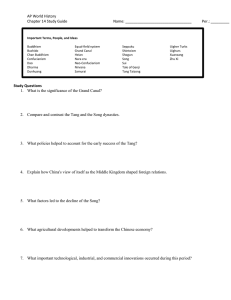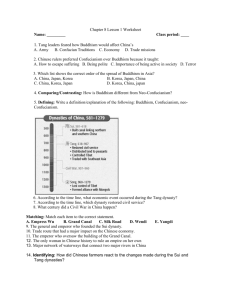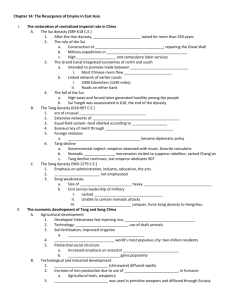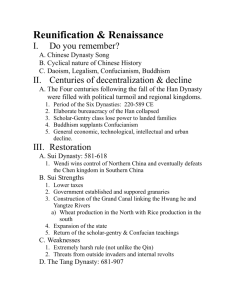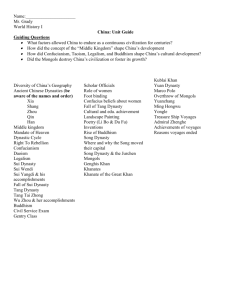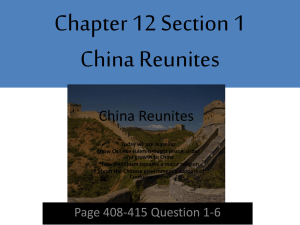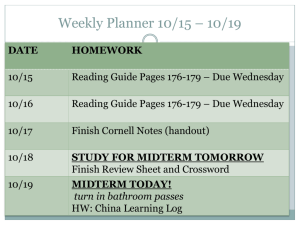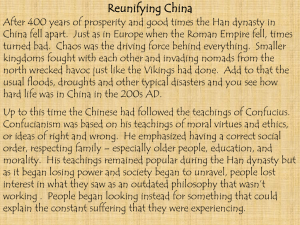Chapter 12 Reunification of China
advertisement
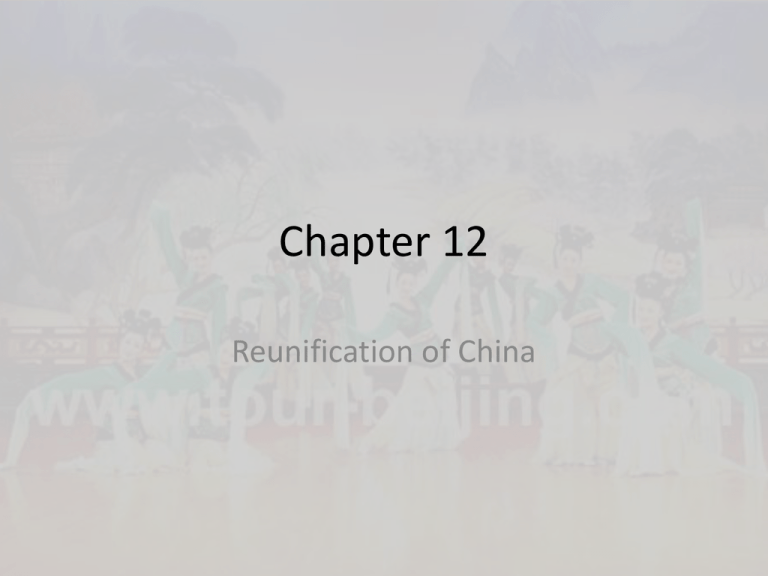
Chapter 12 Reunification of China • Interim period 220 - 589 – – – – – 333 - Roman capital moved to Constantinople 4 C - Beginning of Trans-Saharan Trade Routes 476 - Fall of Rome 527 - Justinian rule of Byzantine Empire 632 - Rise of Islam th • Sui Dynasty 589 CE - 618 • Tang Dynasty 618 CE - 907 – 732 - Battle of Tours (end of Muslim move into France) • Sung Dynasty 969 CE - 1279 – – – – – – 1054 - 1 Schism in Christian Church 1066 - Norman conquest of England 1071 - Battle of Manzikert (Seljuk Turks defeat Byz) 1095 - 1 Crusade 1258 - Mongols sack Baghdad 1271-1295 - Marco Polo travels st st • China undergoes less fundamental change during Post-Classical period than most other center of civilization (W. Europe, Middle East, and the Americas) • Called Era of Division or Six Dynasties Period—all est. capitals at Nanjing – Period marked by nomadic domination & economic decline – Confucianism replaced by Buddhism – Trade & cities decline as nation is decentralized Sui Dynasty • Begins through a series of alliances and military successes Sui Dynasty (589 – 618 CE) Wendi • 1st Sui Emperor • Nobleman • Victory over Chen united traditional Chinese Core. • Built grain bins for storing grain. • Lowered taxes and built massive canals. • Leads nomadic leaders to control northern China • Earned the respect of nomadic peoples Yangdi • • • • 2nd Emperor Murdered Father. Established milder legal code Upgraded Confucian education and restored examination system. • ultimately succumbs to luxuryClear-cuts a forest to build a private game park – Series of unsuccessful wars – Built multiple palaces and a new capitol – Constructs Grand Canal (1200 Miles Long) • Is assassinated Grand Canal Tang Dynasty • Established by military overthrow of Sui leaders – Li Yuan (founder) • Conquest of surrounding territories and nomadic tribes – largest expansion of boundaries of China – Use of Turkic nomads in military – hopes for assimilation – Expansion to Korea (Silla), Vietnam • Golden Age of foreign relations with other countries Japan, Korea, Persia Tang Dynasty (618 – 907 CE) A Whole new world • New technologies: – Printing --> moveable print – Porcelain – Gunpowder – Mechanical clocks • More cosmopolitan culture • Reestablished safety of Silk Road • Rebuild the bureaucratic/administrative system – Resurgence of Confucianism – Social status of scholars exceeds aristocrats (nobles) – Immediate and hereditary benefits for successful examinees • Social status still counts for more than ability Growing importance of the Examination system • Patronized academies to train state officials and educate them in Confucian classics, which were thought to teach moral and organizational principles- Ministry of Rites administered the examinations • Jinshi- those who passed exams on the philosophical and legal classics and Chinese literature • Birth and family position still very importantupper levels of power still dominated by aristocracy- fathers to sons Foot Binding during the Tang Broken toes by 3 years of age. Size 5 ½ shoe on the right Buddhism and Confucianism in the Tang • Confucianism and Buddhism potential rivals – Buddhism had been central – Mahayana Buddhism popular in era of turmoil – Chan (Zen) Buddhism common among elite • Early Tang support Buddhism – Empress Wu (690-705) – Endows monasteries – Tried to make Buddhism the state religion – 50,000 monasteries by c. 850 Conflict between Confucianism and Buddhism • Reversal of state sponsorship – Confucianism regains favor for educational purposes • Confucianism has difficulty competing against the multiple strains of Buddhism • Ultimately Government sponsorship of Buddhism declines because of financial problems – Buddhism is permanently weakened, but never dies out completely Decline of the Tang • • • • • 755 CE, Revolts Ineffective leaders Frontier boarders raided Corrupt government officials 907 CE, last Tang emperor resigns Song Dynasty (960 – 1279 CE) Song Dynasty • Created after a brief lull in political power following collapse of Tang – 960- military commander Zhao Kuangyin emerged to reunite China under single dynasty (educated man) He was renamed emperor Taizu and founded Song dynasty • Unable to completely consolidate power – Routed out all rivals except one- northern Liao dynasty • Founded by the nomadic Khitan peoples from Manchuria • Song forced to pay tribute to keep it from raiding the Song domains – Why is this so bad for the dynasty ?????? • Creation of urban, merchant middle class • Begin rice cultivation • Try to avoid opportunities for corruption that plagued Tang – Results in weakness – Limit power of military leaders: subordinate to scholar-gentry – Relax requirements for civil service exam: bureaucracy becomes less successful • Promote Neo-Confucian ideology over Buddhism: Return to “Classical” Heritage Song Politics • Settling for Partial Restoration – Scholar-gentry patronized – Given power over military • The Revival of Confucian Thought – Libraries established – Old texts recovered • Neo-confucians – – – – – Stress on personal morality Zhu Xi Importance of philosophy in everyday life Hostility to foreign ideas Gender, class, age distinctions reinforced Neo-Confucianism • Emphasized tradition and the pursuit of virtuous morality through ancient texts and the teachings of wise men • Stressed Confucian social stratification! • The past is man’s best example for future Impact of Neo-Confucianism – gender: men revered as household equivalent to emperor – society: encouraged to “stay in your place” – government: less receptive to other “foreign” ideas Problems • Continuous problems with nomads-result of initial weakness with Khitan tribe – Size of standing army becomes incredible drain on finances • Ultimately fall due to civil unrest and nomadic incursion – Jurchens conquer northern kingdom – Briefly establish a smaller kingdom to the south before succumbing to Mongol invasion • Will rise again through Mongol assimilation into Chinese sulture Trends of the Tang and Song • Changes to education: stress analytical thinking vs. rate memorization • Urban sophistication: Hangzhou “The best this is in the world” Economic Trends • Changes to economy: Dominance of Chinese global trade – Sophisticated trading vessels: junks – Creation of trade guilds – Creation of paper money and credit system: Flying money • Trading guilds (hang) handled the transport & sale of grain, salt, tea, and silk • Merchant banks 1st issued currency; credit vouchers • Govt. would issue paper currency of its own; flying money vouchers Junks Technological Advancement Trends • Exploding powder, flamethrowers, poisoned gas, rocket launchers • Suspension and trussed bridges (1st use) Water deviation • Use of coal as fuel/heat sources • Compass for sea navigation • Abacus, moveable type Social Trends • Land reforms limited power of aristocracy and improved lives of peasantry • Improved farming techniques increased food production • Upper-class women improved some (activity, divorce, 2nd husbands) – Pre-marital rules, divorce, education, role in home – Foot binding
